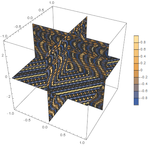SOCR News MIDAS Symposium 2020
Contents
SOCR News & Events: Computational Neuroscience, Time Complexity, and Spacekime Analytics
The 2020 UM Data Science Annual Symposium will take place virtually.
Logistics
- Program
- Dates/Times: Tuesday and Wednesday November 10-11, 2020
- Place: Zoom Event
- Title: Computational Neuroscience, Time Complexity, and Spacekime Analytics
- Presenter: Ivo Dinov, joint work with Milen V. Velev (Burgas University)
- Abstract: The proliferation of digital information in all human experiences presents difficult challenges and offers unique opportunities of managing, modeling, analyzing, interpreting, and visualizing heterogeneous data. There is a substantial need to develop, validate, productize, and support novel mathematical techniques, advanced statistical computing algorithms, transdisciplinary tools, and effective artificial intelligence apps.
- Spacekime analytics is a new technique for modeling high-dimensional longitudinal data, such as functional magnetic resonance imaging (fMRI). This approach relies on extending the notions of time, events, particles, and wavefunctions to complex-time (kime), complex-events (kevents), data and inference-functions, respectively. This talk will illustrate how the kime-magnitude (longitudinal time order) and kime-direction (phase) affect the subsequent predictive analytics and the induced scientific inference. The mathematical foundation of spacekime calculus reveals various statistical implications including inferential uncertainty and a Bayesian formulation of spacekime analytics. Complexifying time allows the lifting of all commonly observed processes from the classical 4D Minkowski spacetime to a 5D spacetime manifold, where a number of interesting mathematical problems arise.
- Spacekime analytics transforms time-varying data, such as time-series observations, into higher-dimensional manifolds representing complex-valued and kime-indexed surfaces (kime-surfaces). This process uncovers some of the intricate structure in high-dimensional data that may be intractable in the classical space-time representation of the data. In addition, the spacekime representation facilitates the development of innovative data science analytical methods for model-based and model-free scientific inference, derived computed phenotyping, and statistical forecasting. Direct neuroscience science applications of spacekime analytics will be demonstrated using simulated data and clinical observations (e.g., UK Biobank).
- Joint work with Milen V. Velev (Burgas University, Bulgaria).
- Slidedeck: Presentation Slides
Background
- SOCR News & Events
- SOCR Global Users
- SOCR Navigators
- SOCR Datasets and Challenging Case-studies
- Electronic Textbooks:
References
- This work is sponsored in part by NIH Grants P30 DK089503, P20 NR015331, R01CA233487, and R01MH121079, as well as, NSF Grants 1916425, 1734853 and 1636840.
- Dinov, ID and Velev, MV (2021) Data Science: Time Complexity, Inferential Uncertainty, and Spacekime Analytics, De Gruyter (STEM Series), Berlin/Boston, ISBN 9783110697803 / 3110697807.
- SOCR Home page: https://www.socr.umich.edu
Translate this page:

